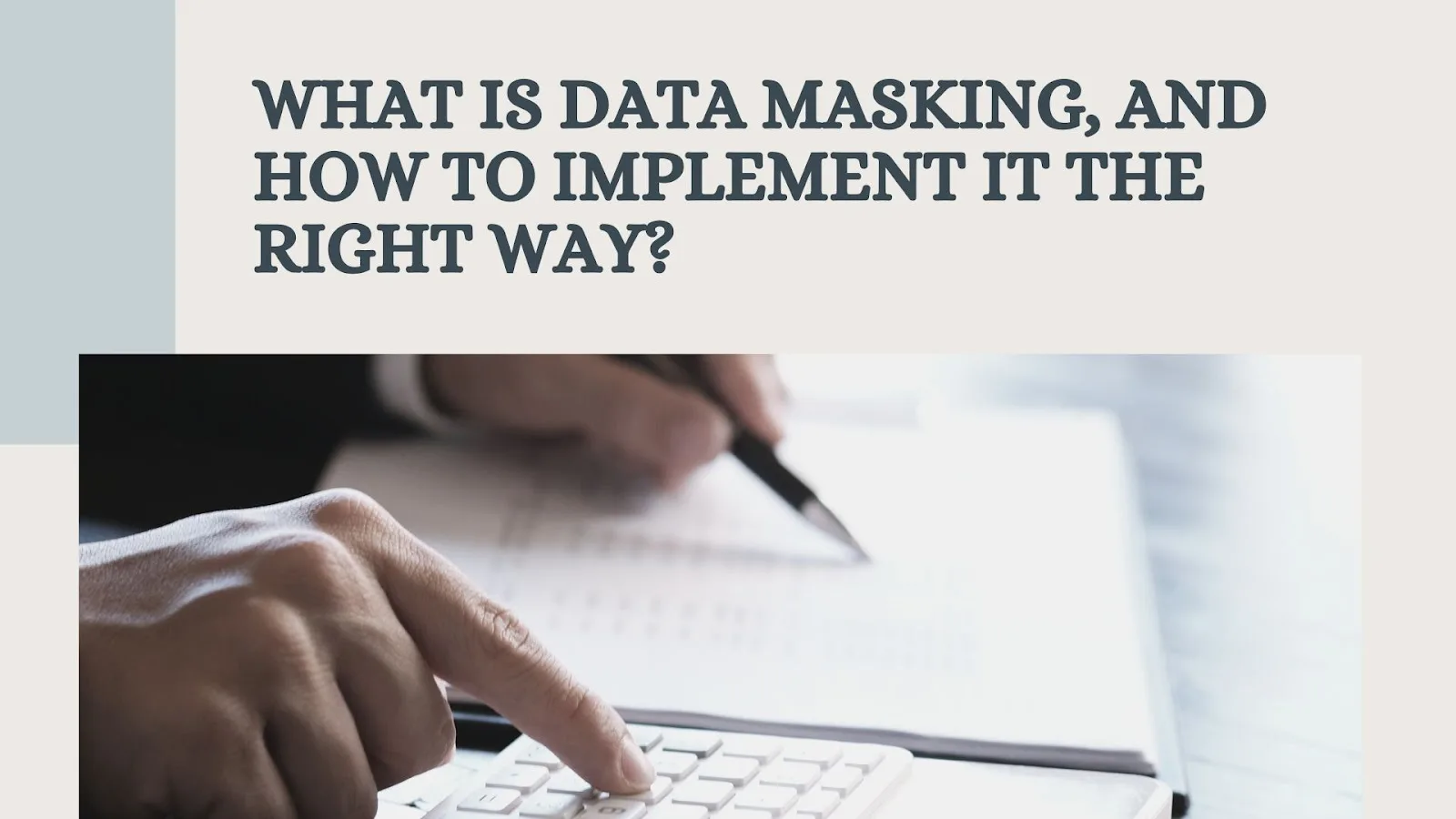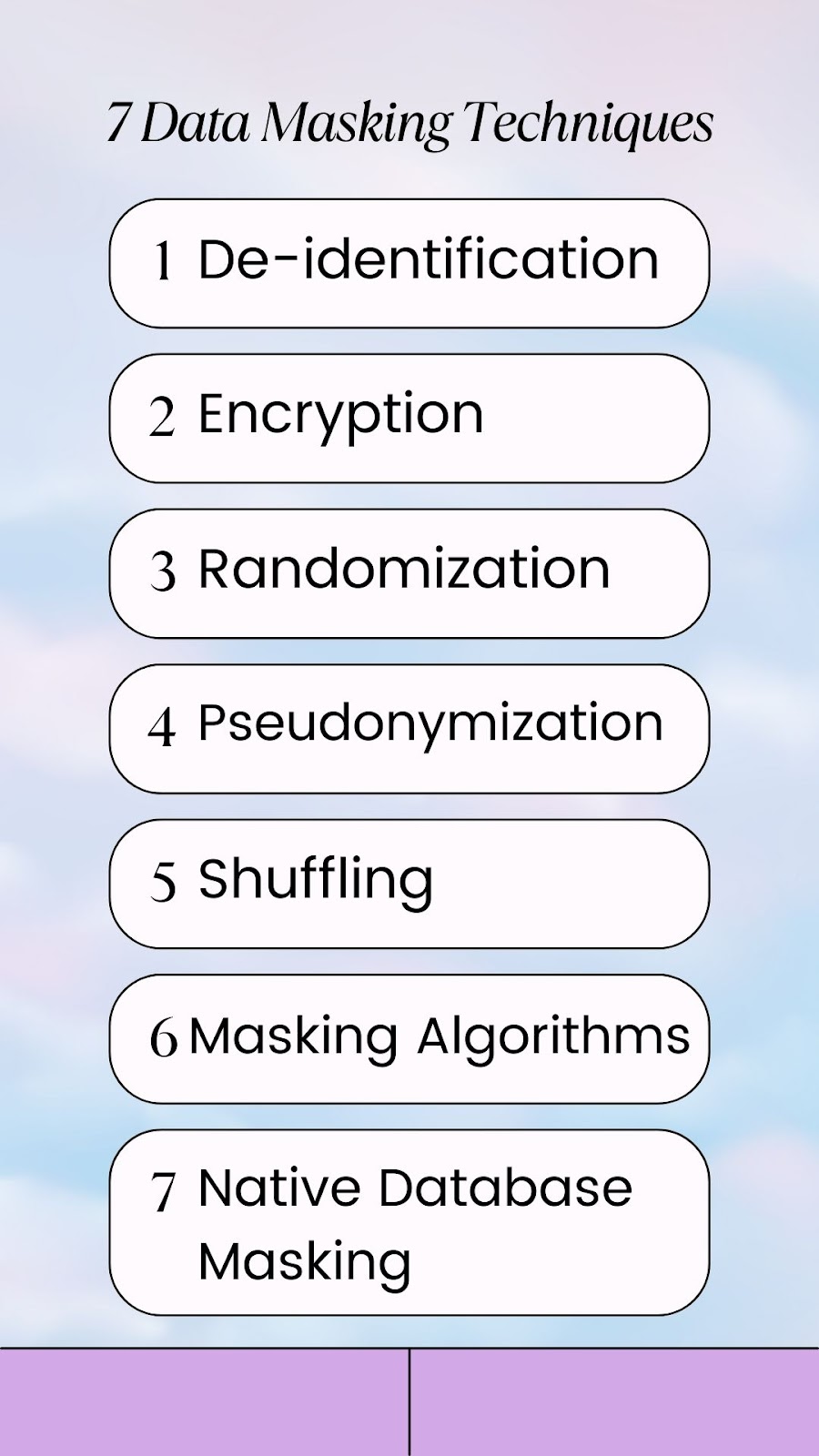
What Is Data Masking, and How to Implement It the Right Way?
Data breaches frequently make headlines in today’s world. Every organization that handles sensitive customer information frets about being next. However, what if your company could still utilize data to enhance products and services without risking exposure?
This is precisely what data masking enables. By scrubbing sensitive fields in datasets and replacing them with artificial data, organizations can extract more value from their data while maintaining privacy and security. No more tense tradeoffs.
But haphazardly throwing masking at your data won’t cut it. To do it right requires thoughtful implementation: choosing techniques tailored for each data type, governing access strictly, and monitoring continuously as new data emerges.
That’s what we’ll unpack today – best practices for applying data masking judiciously to balance usability with air-tight protection. Because masking is useless if applied recklessly or not at all. But when done right, it’s one of the most potent tools for eliminating data risks while tapping its potential. Let’s get started.
What is Data Masking?
Let’s delve into what is data masking refers to: obscuring or replacing sensitive information in databases, files, spreadsheets, etc. with fake data that has a similar format. The original data format and type are retained, but the real values are replaced with realistic but false data.
For example, a data masking technique can replace real credit card numbers with randomly generated yet plausible credit card numbers. Social security numbers can be swapped with algorithmically produced SSNs indistinguishable from real ones.
In today’s digital landscape, effective data masking strategies are essential for protecting sensitive information. However, successful implementation of data masking techniques relies on seamless integration with robust access management and user provisioning solutions. It’s imperative that organizations secure access to masked data across their entire ecosystem, from core to cloud environments. By integrating data masking capabilities with these essential tools, companies can maintain data confidentiality while enabling controlled access across various user roles and permissions. A holistic approach to data security, spanning from the organization’s core infrastructure to cloud-based platforms, is paramount in mitigating risks and ensuring compliance with data privacy regulations.
The main goal of data masking is to protect confidential personal or financial data from unauthorized access and abuse. Organizations use data masking to share their data with third parties, lower environments, offshore teams, or untrusted users without exposing sensitive customer information.
Why is Data Masking Important?
Here are some key reasons why data masking is critical for modern data security:
-
Compliance with data privacy regulations – Laws like GDPR impose heavy penalties for organizations that fail to protect personal data. Data masking limits compliance risk.
-
Prevent data breaches – Masking secures sensitive data against both external and internal threats. This minimizes damage if a breach occurs.
-
Enable development & testing – Teams can use masked production data for testing apps without compromising customer privacy.
-
Share data safely – Masking allows organizations to share data with vendors, partners, and other third parties without revealing confidential data.
Selecting Masking Techniques
Choosing masking techniques depends on data type, sensitivity, intended usage etc. For example:
-
Encryption for highly sensitive data like passwords, financials
-
Pseudonymization for private customer data shared externally
-
De-identification for anonymizing personal data for analytics
-
Randomization for test data, system IDs, coordinates etc.
-
Substitution for masking parts of unstructured data like text
-
Shuffling/Redaction for masking patterns but retaining statistics
The optimal approach may also combine techniques like encrypting data but pseudonymization metadata. Proper implementation is key – using robust algorithms, secure keys, and formats that maintain readability.
Data Masking Techniques & Methods

There are several techniques to mask sensitive information depending on your specific needs:
De-identification
De-identification is one of the most common data masking techniques and involves removing personally identifiable information (PII) like names, emails, social security numbers, etc. from a dataset. The original data format is retained, but any fields containing identifying data are either removed entirely or replaced with pseudonyms or dummy values.
De-identification ensures that individuals can no longer be identified from the data, which is important for compliance with privacy regulations. It allows organizations to derive useful insights from consumer data without compromising user privacy.
Encryption
Encryption converts sensitive data into coded form so that only authorized parties with the cryptographic key can access the real data. The data remains usable in encrypted form but is scrambled into an unreadable ciphertext. Modern encryption algorithms like AES and RSA are highly secure when implemented correctly.
Encryption provides very strong protection for confidential personal and financial data. Organizations can securely share or transmit encrypted data without revealing actual sensitive values. Encryption keeps data usable for analytics too.
Randomization
Randomization exchanges real data values with randomly generated, but valid dummy values. The key is to replace real data with fake yet realistic data in the same format. For example, actual phone numbers can be swapped with algorithmically generated fictional numbers in a valid phone number format.
Randomization provides good protection for less sensitive data like phone numbers, product IDs, or geographic coordinates where the exact values don’t matter. The data remains usable for testing or development purposes.
Pseudonymization
Pseudonymization is the process of replacing identifiable information such as names or emails with artificial identifiers or pseudonyms. For example, a name can be replaced with a fake name or numeric pseudonym like User1234.
While less anonymous than techniques like encryption, pseudonymization can help reduce the risk of identification from the data. It provides stronger security than plain-text data with direct identifiers.
Shuffling
Shuffling refers to mixing up parts of the data, like randomizing the order of rows or columns in a database table, to prevent accessing the complete original records. For example, shuffling can rearrange columns in a table randomly to mask full customer profiles.
Shuffling helps reduce the value of data for fraud analytics while still keeping it usable for aggregate analytics like statistics. It provides a light level of masking suitable for some use cases.
Masking Algorithms
Sophisticated data masking algorithms can generate fictional yet appropriate dummy data for fields like credit card numbers, national ID numbers, addresses, etc. Advanced generators can produce data that passes validation checks and looks authentic.
Algorithmic masking provides very realistic and seemingly valid masked data. It ensures readability and usability for downstream usage. However, generating high-quality dummy data can be complex.
Native Database Masking
Many enterprise databases like Oracle, SQL Server, SAP HANA, Teradata, etc. provide built-in dynamic data masking capabilities. This allows masking sensitive data on the fly as it’s queried without altering the actual stored data.
Native database masking simplifies implementation and ensures data security policies are consistently applied whenever data is accessed. Masking logic stays in the database itself for easier management.
Best Practices for Data Masking
Follow these vital best practices when implementing a data masking strategy:
-
Mask data as close to the source as possible to limit the visibility of real data.
-
Only allow masked data in non-production environments. Masking should not impact real data in production.
-
Control access to masking tools to prevent unauthorized or accidental unmasking of data.
-
Mask data flows between systems, not just data at rest. This includes reports, extracts, replicas etc.
-
Mask data from your organization as well as third parties. Both internal and external data can carry risk.
Additional Masking Methods
Advanced masking approaches include:
-
Tokenization: replacing data with system-generated tokens
-
Hashing: one-way cryptographic scrambling of data
-
Redaction: completely blacking out or removing data
-
Subtype substitution: replacing parts of unstructured data with realistic fake values
-
Synthetic data: generating artificial data representative of original
These help provide stronger protection for ultra-sensitive data. But may reduce utility if they impact formats, patterns etc. Proper implementation is vital to balance security and usability.
Data Privacy Regulations and Compliance
Data masking plays an important role in helping organizations comply with data privacy laws and regulations. Regulations like the EU’s General Data Protection Regulation (GDPR) and California Consumer Privacy Act (CCPA) impose strict requirements around securing and protecting personal data. Fines for non-compliance can be massive – up to 4% of global revenue under GDPR.
Data masking techniques like encryption, pseudonymization, and de-identification help organizations follow mandates in these regulations to protect customer data and minimize compliance risk. For example, GDPR requires the use of pseudonymization for certain data processing activities. CCPA has exemptions for properly de-identified or aggregated data. Implementing masking best practices demonstrates an organization is taking reasonable steps to safeguard personal information.
Conclusion
Data masking provides indispensable protection and privacy for sensitive customer, employee, and organization data. With rising data volumes across businesses and stiff regulations like GDPR, robust data masking strategies are a must.
Carefully choosing masking techniques based on your specific regulatory, risk, and data-sharing needs is key to successful implementations. Equally important are thorough masking procedures and controls to prevent lapses.
With proper planning and precautions, organizations can leverage data masking to unlock data’s value – via analytics, development, sharing, and more – without compromising critical data security.
Key Takeaways
-
Data masking hides sensitive information by replacing real data with fake, randomized data to protect privacy and security.
-
Proper data masking limits compliance risks, prevents breaches and enables data sharing without exposing sensitive data.
-
Common masking techniques include encryption, tokenization, shuffling, and pseudonymization. Choose based on data sensitivity.
-
Best practices include masking data close to the source, maintaining formats/types, controlling access, and monitoring continuously.
-
With careful implementation, data masking allows organizations to unlock data’s value while upholding robust security.
FAQs
What are the benefits of data masking?
Data masking helps meet compliance needs, improves security, enables safe testing, and allows controlled data sharing without exposing sensitive information.
When should you mask data instead of encrypting it?
Data masking is preferable over encryption when usability and readability of data are required by downstream users or systems.
What data types are commonly masked?
Personally identifiable information, financial data, healthcare records, and intellectual property are often masked to protect confidentiality.
Can masked data be reversed to original values?
The reversibility of masking depends on the technique – encryption is reversible while hashing and tokenization are not.
Source: ArticleCube


